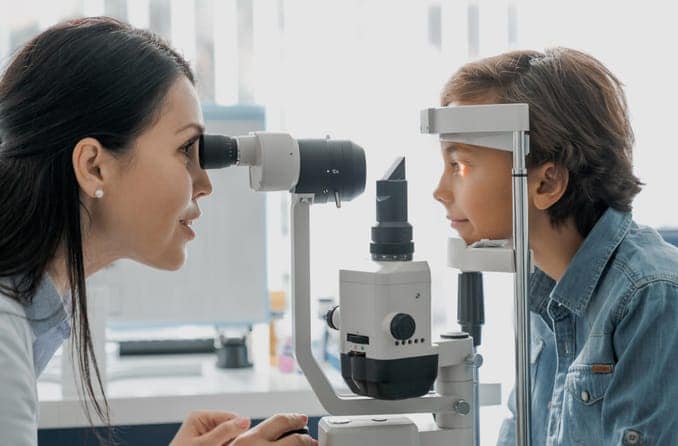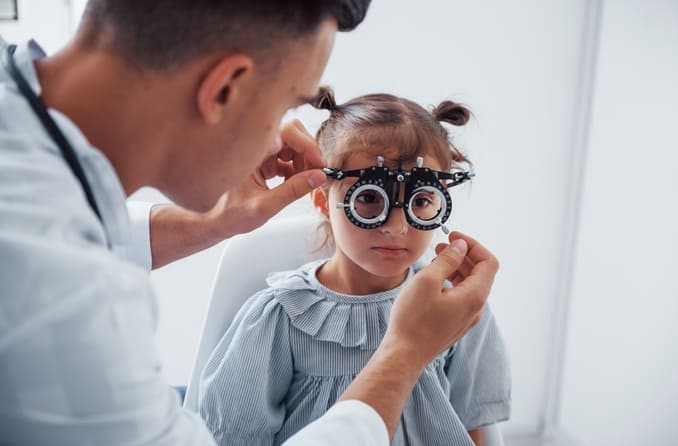Eye contact is an important way for parents to communicate with their child. But what if your child has a social or physical disability that makes this difficult or impossible? Will a lack of eye contact negatively influence their development?
Children absorb the world around them and develop their ability to communicate using their visual sense. Children who are unable to make eye contact, due to developmental disorders or blindness, can learn to adapt to effectively build relationships.
How does eye contact affect a child’s development?
The majority of information we receive is initially processed through our vision. Although vision isn’t fully developed at birth, infants as young as 2 days old have been observed to show a preference for faces looking back at them.
Dr. Nerissa Bauer, developmental pediatrician with You Doctors Online, says that eye contact is important for social–emotional and language development.
In fact, studies have shown that eye contact leads to greater language skills by age 2.
“Visual development influences fine motor skills like picking up and manipulating objects,” Bauer says. “This eventually develops into writing and other activities that require hand-eye coordination.”
Bauer says that beginning at birth, pediatricians will evaluate a baby’s vision and monitor it due to its close correlation to other areas of development. Certain eye problems can be an early sign of a neurological or systemic issue.
IS YOUR BABY AVOIDING EYE CONTACT? Book an eye exam with a children's optometrist near you.
See related: Pediatric optometrist
Eye contact in children with autism
What is autism and how does it affect eye contact?
Shelli Dry, doctor of occupational therapy and clinical director at Enable My Child, describes autism as a social disorder. However, many individuals with autism (although not all) also experience sensory disorders.
“Their sensory system is on high alert. They feel, hear and see things at a higher stimulation level than others and can get overwhelmed by too much sensory input,” Dry says.
She adds that the many facial expression changes that occur throughout a conversation are often reflected through a person’s eyes.
“Just by making eye contact, you’re seeing all of the different ways a person can look depending on their expressions," she says. “Imagine how overwhelming that can be for someone with sensory delays.”
Overstimulation is the reason autistic individuals often prefer to avoid eye contact, unless taught and practiced otherwise.
Is it possible for someone with autism to make eye contact with no trouble?
Yes. Because autism is a spectrum disorder, the presence and severity of symptoms vary greatly. And eye contact can improve over time.
“As individuals with autism mature, they develop new strategies,” she explains. “Many times, they’re able to overcome problems that really affected them when they were younger.”
These strategies are usually developed with help from parents or caretakers, she adds.
Should parents of an autistic child encourage eye contact at home?
According to AutismSpeaks.org, encouraging eye contact is something parents should try with their child, but forcing eye contact may do more harm than good.
Why? Eye contact can be very stressful for those with autism. It can distract them from listening to the actual message being communicated by the person they’re making eye contact with.
Dry says parents should attempt teaching eye contact. When more leeway is given to communicate in a way the child feels comfortable, they’re more likely to engage and participate.
“You should always give the child the benefit of the doubt — never say ‘We’re not going to work on that because it’s hard,’” she says. “If you’ve tried but find that it’s not beneficial to the child and it’s not accomplishing anything, then teach them other methods to show they’re paying attention.”
These methods include:
- Encouraging the child to stay a conversational distance from whomever is speaking to them and avoid wandering off in the middle of conversation.
- Teaching the child to look toward the face without looking directly into the eyes (e.g., focus on the forehead or nose).
- Condition the child to provide responses to show that they’re paying attention (a gentle pat, an “uh-huh” or “yes”).
SEE RELATED: Your infant's vision development: What to know
Eye contact with blind or visually impaired children
How does the social development of a blind child compare to that of a seeing child?
Early onset blindness has a greater overall effect on the development of social cues than if it occurs later in life.
Bauer says eye contact is important for the “social brain,” including the amygdala, where emotions are processed. Because of this, it's difficult for visually impaired children to recognize non-verbal and social cues, which makes it harder for them to interact socially.
An article from Perkins School for the Blind offers five ways to help a blind child develop social skills. These include explaining social cues to your child, practicing verbal and non-verbal interactions at home, and exposing your child to different social situations.
What about children who have one or more blind parents? How is their nonverbal behavior different from a child of seeing parents?
Children who are born to blind parents experience a level of adaptation that research shows is almost immediate.
A 2013 study monitored the first year of life for five sighted infants born to blind mothers. During the second half of their first year, the infants responded normally when interacting with sighted adults, but modified their behavior to accommodate their blind parents when interacting with them.
The need to switch between visual and auditory communication channels leads to aspects of development that are consistent with infants who grow up bilingually and must switch between spoken languages.
SEE RELATED: Baby's first eye exam
Other factors affecting children’s eye contact
Within the past several years, there’s been an increase in the number of children being given phones and tablets at an earlier age. This exposure is causing a delay in children’s social engagement and eye contact because they’re constantly looking away to stare at a tablet or phone.
To combat the social effects of excessive screen time, the American Academy of Pediatrics makes the following recommendations:
- Avoid screen time in children under 18 months of age, unless it’s video chatting.
- Choose high-quality programming for children 18-24 months and watch it with them to help them understand what they’re seeing.
- Children 2-5 years old should be limited to one hour of quality programming per day.
- Allow children equal exposure to social engagements without a screen in front of them.
HAS YOUR CHILD HAD AN EYE EXAM YET? Schedule an appointment with a pediatric eye doctor near you.
READ NEXT: How much screen time is okay for my child?










